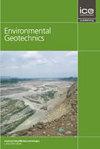Borehole Analysis with the Modification of RQD Value
IF 2.2
4区 工程技术
Q3 ENGINEERING, GEOLOGICAL
引用次数: 0
Abstract
The most common classification method of drill cores is the Rock Quality Designation (RQD) value, which indicates the percentage of rock cores longer than 10 cm in a given core section. This core logging procedure is the basic parameter in the most useful rock mass classification methods like Rock Mass Rate (RMR) and Rock Mass Quality (Q). It is also used to determine the Geological Strength Index (GSI), which has become widely used in the last 20 years. One of the basic problems of the RQD value is that it does not distinguish different rock cores longer than 10 cm (100% is obtained for one piece of 1 m length and 10 pieces of 10 cm length) and a uniform result is obtained for shorter units. In this paper, the so-called Integrated RQD (Int_RQD) factor is introduced to eliminate these problems and to provide a better description of fracture density in the core logging procedure. As it uses the original core logging procedure, historical RQD data can also be reevaluated. Considering that RQD is an input parameter for most rock engineering classifications, these systems such as GSI can be reviewed based on the new RQD definition proposed herein.修正RQD值的井眼分析
最常用的岩心分类方法是岩石质量标识(RQD)值,它表示给定岩心剖面中长度大于10厘米的岩心的百分比。该岩心测井程序是最常用的岩体分类方法(如岩体率(RMR)和岩体质量(Q))的基本参数,也用于确定地质强度指数(GSI),这在近20年来得到了广泛应用。RQD值的一个基本问题是不能区分长度大于10 cm的岩心(1 m和10 cm的岩心分别为100%),而长度较短的岩心得到的结果是一致的。本文引入了所谓的综合RQD (Int_RQD)因子来消除这些问题,并在岩心测井过程中更好地描述裂缝密度。由于它使用原始岩心测井程序,历史RQD数据也可以重新评估。考虑到RQD是大多数岩石工程分类的输入参数,可以根据本文提出的新的RQD定义对GSI等系统进行审查。
本文章由计算机程序翻译,如有差异,请以英文原文为准。
求助全文
约1分钟内获得全文
求助全文
来源期刊

Environmental geotechnics
Environmental Science-Water Science and Technology
CiteScore
6.20
自引率
18.20%
发文量
53
期刊介绍:
In 21st century living, engineers and researchers need to deal with growing problems related to climate change, oil and water storage, handling, storage and disposal of toxic and hazardous wastes, remediation of contaminated sites, sustainable development and energy derived from the ground.
Environmental Geotechnics aims to disseminate knowledge and provides a fresh perspective regarding the basic concepts, theory, techniques and field applicability of innovative testing and analysis methodologies and engineering practices in geoenvironmental engineering.
The journal''s Editor in Chief is a Member of the Committee on Publication Ethics.
All relevant papers are carefully considered, vetted by a distinguished team of international experts and rapidly published. Full research papers, short communications and comprehensive review articles are published under the following broad subject categories:
geochemistry and geohydrology,
soil and rock physics, biological processes in soil, soil-atmosphere interaction,
electrical, electromagnetic and thermal characteristics of porous media,
waste management, utilization of wastes, multiphase science, landslide wasting,
soil and water conservation,
sensor development and applications,
the impact of climatic changes on geoenvironmental, geothermal/ground-source energy, carbon sequestration, oil and gas extraction techniques,
uncertainty, reliability and risk, monitoring and forensic geotechnics.
 求助内容:
求助内容: 应助结果提醒方式:
应助结果提醒方式:


